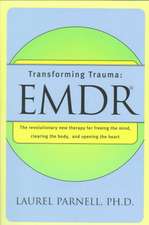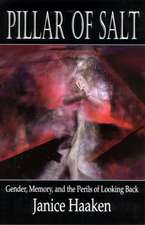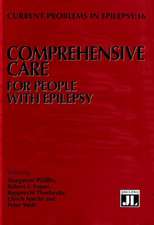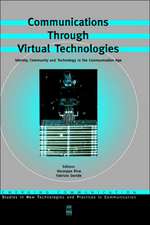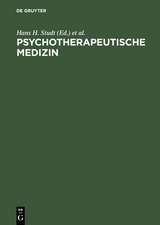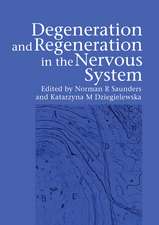Autism: The Movement Sensing Perspective: Frontiers in Neuroscience
Editat de Elizabeth B. Torres, Caroline Whyatten Limba Engleză Hardback – 3 oct 2017
This book reaches beyond subjective descriptions of autistic phenomena and embraces a new era of objective measurements, analyses, and statistical inferences. The authors harness activities from the nervous systems across the brain and body (often in tandem), and introduce a platform for the comprehensive personalized phenotyping of individuals with autism. The impact of this approach is discussed to advance the development of tailored treatments options, enhance the ability to longitudinally track symptomatology, and to fundamentally empower affected individuals and their families. This book encompasses a new era for autism research and treatments, and our continuous effort to collectively empower and embrace the autistic community.
| Toate formatele și edițiile | Preț | Express |
|---|---|---|
| Paperback (1) | 424.26 lei 6-8 săpt. | |
| CRC Press – 30 mar 2021 | 424.26 lei 6-8 săpt. | |
| Hardback (1) | 1098.75 lei 6-8 săpt. | |
| CRC Press – 3 oct 2017 | 1098.75 lei 6-8 săpt. |
Din seria Frontiers in Neuroscience
- 27%
 Preț: 1048.22 lei
Preț: 1048.22 lei - 18%
 Preț: 969.43 lei
Preț: 969.43 lei - 9%
 Preț: 319.88 lei
Preț: 319.88 lei - 5%
 Preț: 424.26 lei
Preț: 424.26 lei - 9%
 Preț: 320.30 lei
Preț: 320.30 lei - 14%
 Preț: 315.76 lei
Preț: 315.76 lei - 24%
 Preț: 435.02 lei
Preț: 435.02 lei - 15%
 Preț: 566.66 lei
Preț: 566.66 lei - 25%
 Preț: 456.63 lei
Preț: 456.63 lei - 15%
 Preț: 503.98 lei
Preț: 503.98 lei - 10%
 Preț: 326.59 lei
Preț: 326.59 lei - 18%
 Preț: 1333.33 lei
Preț: 1333.33 lei -
 Preț: 465.42 lei
Preț: 465.42 lei - 5%
 Preț: 1101.07 lei
Preț: 1101.07 lei - 18%
 Preț: 1335.94 lei
Preț: 1335.94 lei - 18%
 Preț: 1352.99 lei
Preț: 1352.99 lei - 18%
 Preț: 1364.09 lei
Preț: 1364.09 lei - 18%
 Preț: 1348.29 lei
Preț: 1348.29 lei - 18%
 Preț: 1355.43 lei
Preț: 1355.43 lei - 18%
 Preț: 1342.79 lei
Preț: 1342.79 lei - 9%
 Preț: 322.18 lei
Preț: 322.18 lei - 30%
 Preț: 1014.67 lei
Preț: 1014.67 lei - 30%
 Preț: 1017.59 lei
Preț: 1017.59 lei - 28%
 Preț: 1046.00 lei
Preț: 1046.00 lei - 22%
 Preț: 323.27 lei
Preț: 323.27 lei - 29%
 Preț: 1018.16 lei
Preț: 1018.16 lei - 18%
 Preț: 1155.27 lei
Preț: 1155.27 lei - 30%
 Preț: 1016.87 lei
Preț: 1016.87 lei - 28%
 Preț: 1045.38 lei
Preț: 1045.38 lei - 27%
 Preț: 1047.86 lei
Preț: 1047.86 lei - 28%
 Preț: 987.07 lei
Preț: 987.07 lei
Preț: 1098.75 lei
Preț vechi: 1333.40 lei
-18% Nou
Puncte Express: 1648
Preț estimativ în valută:
210.24€ • 220.10$ • 173.96£
210.24€ • 220.10$ • 173.96£
Carte tipărită la comandă
Livrare economică 05-19 aprilie
Preluare comenzi: 021 569.72.76
Specificații
ISBN-13: 9781482251630
ISBN-10: 1482251639
Pagini: 404
Ilustrații: 66
Dimensiuni: 178 x 254 x 27 mm
Greutate: 0.88 kg
Ediția:1
Editura: CRC Press
Colecția CRC Press
Seria Frontiers in Neuroscience
ISBN-10: 1482251639
Pagini: 404
Ilustrații: 66
Dimensiuni: 178 x 254 x 27 mm
Greutate: 0.88 kg
Ediția:1
Editura: CRC Press
Colecția CRC Press
Seria Frontiers in Neuroscience
Public țintă
Professional Practice & Development and Professional ReferenceCuprins
Preface............................................................................................................................................xiii
Foreword .........................................................................................................................................xv
Contributors............................................................................................................. .....................xvii
SECTION I The Big Question: Why Study Movement?
Chapter 1 Why Study Movement Variability in Autism? ............................................................3
Maria Brincker and Elizabeth B. Torres
Chapter 2 The Autism Phenotype: Physiology versus Psychology? ..........................................23
Caroline Whyatt
Chapter 3 Can Cognitive Theories Help to Understand Motor Dysfunction in
Autism Spectrum Disorder? .......................................................................................43
Nicci Grace, Beth P. Johnson, Peter G. Enticott, and Nicole J. Rinehart
Concluding Remarks to Section I: Top-Down versus Bottom-Up Approaches to Connect
Cognition and Somatic Motor Sensations ........................57
SECTION II Basic Research: Movement as a Social Model
Chapter 4 Dissecting a Social Encounter from Three Different Perspectives ............................63
Elizabeth B. Torres
Chapter 5 More Than Meets the Eye: Redefining the Role of Sensory-Motor Control on
Social Skills in Autism Spectrum Disorders ..............................................................73
Caroline Whyatt
Chapter 6 Action Evaluation and Discrimination as Indexes of Imitation Fidelity in Autism........89
Justin H. G. Williams
Chapter 7 ADOS: The Physiology Approach to Assess Social Skills and
Communication in Autism Spectrum Disorder ........................................................103
Caroline Whyatt and Elizabeth B. Torres
Chapter 8 On the Brainstem Origin of Autism: Disruption to Movements of the Primary Self ..... 119
Jonathan Delafield-Butt and Colwyn Trevarthen
ix
.
Chapter 9 The Gap between Intention and Action: Altered Connectivity and
GABA-mediated Synchrony in Autism ...................................................................139
John P. Hussman
SECTION III Let’s Get the Math Right to Improve Diagnosis,
Research, and Treatment Outcomes
Preface to Section III: First Things First–Let Us Get the Math Right...................................153
Chapter 10 Non-Gaussian Statistical Distributions Arising in Large-Scale Personalized
Data Sets from Biophysical Rhythms of the Nervous Systems ...............................155
Jorge V. José
Chapter 11 Excess Success for a Study on Visual Search and Autism: Motivation to
Change How Scientists Analyze Data......................................................................165
Gregory Francis
Chapter 12 Contemporary Problems with Methods in Basic Brain Science Impede
Progress in ASD Research and Treatments..............................................................177
Elizabeth B. Torres
Chapter 13 Inherent Noise Hidden in Nervous Systems’ Rhythms Leads to
New Strategies for Detection and Treatments for Core Motor Sensing
Traits in ASD ...........................................................................................................197
Elizabeth B. Torres
Chapter 14 Micromovements: The s-Spikes as a Way to "Zoom In" the Motor
Trajectories of Natural Goal-Directed Behaviors.....................................................217
Di Wu, Elizabeth B. Torres, and Jorge V. José
SECTION IV The Therapeutic Model: Movement as a Percept
to Awaken the Mind
Preface to Section IV ...................................................................................................................227
Chapter 15 Rhythm and Movement for Autism Spectrum Disorder:
A Neurodevelopmental Perspective .........................................................................229
Blythe LaGasse, Michelle Welde Hardy, Jenna Anderson, and Paige Rabon
Chapter 16 Use of Video Technology to Support Persons Affected with
Sensory-Movement Differences and Diversity ........................................................243
Sharon Hammer, Lisa Ladson, Max McKeough, Kate McGinnity, and Sam Rogers
x Contents
Chapter 17 Argentinian Ambulatory Integral Model to Treat Autism Spectrum
Disorders...................................................................................................................253
Silvia Baetti
Chapter 18 Autism Sports and Educational Model for Inclusion (ASEMI)...............................271
Marcelo Biasatti and Maximiliano Lombardo
Chapter 19 Reframing Autism Spectrum Disorder for Teachers:
An Interdisciplinary Task.........................................................................................281
Corinne G. Catalano
Concluding Remarks to Section IV............................................................................................289
SECTION V Autism, the Untold Story from the Perspectives
of Parents and Self-advocates
Preface Section V .........................................................................................................................293
Chapter 20 Seeing Movement: Implications of the Movement Sensing Perspective
for Parents ................................................................................................................295
Pat Amos
Chapter 21 Shiloh: The Outstanding Outlier ..............................................................................327
Summer Pierce
Chapter 22 Ada Mae: Our Magical Fairy ...................................................................................333
Jonathan Grashow and Kathryn Grashow
Chapter 23 It’s a Girl’s Life........................................................................................................339
Jadyn Waiser, Michelle Stern Waiser, and Anita Breslin
Chapter 24 Treat the Whole, Not the Parts.................................................................................347
Chapter 25 Anthony’s Story: Finding Normal............................................................................353
Cynthia Baeza
Chapter 26 Autism: A Bullying Perspective...............................................................................357
Sejal Mistry and Caroline Whyatt
Contents xi
Chapter 27 Turning the Tables: Autism Shows the Social Deficit of Our Society ....................367
Elizabeth B. Torres
Conclusions ...................................................................................................................................379
Index..............................................................................................................................................381
Foreword .........................................................................................................................................xv
Contributors............................................................................................................. .....................xvii
SECTION I The Big Question: Why Study Movement?
Chapter 1 Why Study Movement Variability in Autism? ............................................................3
Maria Brincker and Elizabeth B. Torres
Chapter 2 The Autism Phenotype: Physiology versus Psychology? ..........................................23
Caroline Whyatt
Chapter 3 Can Cognitive Theories Help to Understand Motor Dysfunction in
Autism Spectrum Disorder? .......................................................................................43
Nicci Grace, Beth P. Johnson, Peter G. Enticott, and Nicole J. Rinehart
Concluding Remarks to Section I: Top-Down versus Bottom-Up Approaches to Connect
Cognition and Somatic Motor Sensations ........................57
SECTION II Basic Research: Movement as a Social Model
Chapter 4 Dissecting a Social Encounter from Three Different Perspectives ............................63
Elizabeth B. Torres
Chapter 5 More Than Meets the Eye: Redefining the Role of Sensory-Motor Control on
Social Skills in Autism Spectrum Disorders ..............................................................73
Caroline Whyatt
Chapter 6 Action Evaluation and Discrimination as Indexes of Imitation Fidelity in Autism........89
Justin H. G. Williams
Chapter 7 ADOS: The Physiology Approach to Assess Social Skills and
Communication in Autism Spectrum Disorder ........................................................103
Caroline Whyatt and Elizabeth B. Torres
Chapter 8 On the Brainstem Origin of Autism: Disruption to Movements of the Primary Self ..... 119
Jonathan Delafield-Butt and Colwyn Trevarthen
ix
.
Chapter 9 The Gap between Intention and Action: Altered Connectivity and
GABA-mediated Synchrony in Autism ...................................................................139
John P. Hussman
SECTION III Let’s Get the Math Right to Improve Diagnosis,
Research, and Treatment Outcomes
Preface to Section III: First Things First–Let Us Get the Math Right...................................153
Chapter 10 Non-Gaussian Statistical Distributions Arising in Large-Scale Personalized
Data Sets from Biophysical Rhythms of the Nervous Systems ...............................155
Jorge V. José
Chapter 11 Excess Success for a Study on Visual Search and Autism: Motivation to
Change How Scientists Analyze Data......................................................................165
Gregory Francis
Chapter 12 Contemporary Problems with Methods in Basic Brain Science Impede
Progress in ASD Research and Treatments..............................................................177
Elizabeth B. Torres
Chapter 13 Inherent Noise Hidden in Nervous Systems’ Rhythms Leads to
New Strategies for Detection and Treatments for Core Motor Sensing
Traits in ASD ...........................................................................................................197
Elizabeth B. Torres
Chapter 14 Micromovements: The s-Spikes as a Way to "Zoom In" the Motor
Trajectories of Natural Goal-Directed Behaviors.....................................................217
Di Wu, Elizabeth B. Torres, and Jorge V. José
SECTION IV The Therapeutic Model: Movement as a Percept
to Awaken the Mind
Preface to Section IV ...................................................................................................................227
Chapter 15 Rhythm and Movement for Autism Spectrum Disorder:
A Neurodevelopmental Perspective .........................................................................229
Blythe LaGasse, Michelle Welde Hardy, Jenna Anderson, and Paige Rabon
Chapter 16 Use of Video Technology to Support Persons Affected with
Sensory-Movement Differences and Diversity ........................................................243
Sharon Hammer, Lisa Ladson, Max McKeough, Kate McGinnity, and Sam Rogers
x Contents
Chapter 17 Argentinian Ambulatory Integral Model to Treat Autism Spectrum
Disorders...................................................................................................................253
Silvia Baetti
Chapter 18 Autism Sports and Educational Model for Inclusion (ASEMI)...............................271
Marcelo Biasatti and Maximiliano Lombardo
Chapter 19 Reframing Autism Spectrum Disorder for Teachers:
An Interdisciplinary Task.........................................................................................281
Corinne G. Catalano
Concluding Remarks to Section IV............................................................................................289
SECTION V Autism, the Untold Story from the Perspectives
of Parents and Self-advocates
Preface Section V .........................................................................................................................293
Chapter 20 Seeing Movement: Implications of the Movement Sensing Perspective
for Parents ................................................................................................................295
Pat Amos
Chapter 21 Shiloh: The Outstanding Outlier ..............................................................................327
Summer Pierce
Chapter 22 Ada Mae: Our Magical Fairy ...................................................................................333
Jonathan Grashow and Kathryn Grashow
Chapter 23 It’s a Girl’s Life........................................................................................................339
Jadyn Waiser, Michelle Stern Waiser, and Anita Breslin
Chapter 24 Treat the Whole, Not the Parts.................................................................................347
Chapter 25 Anthony’s Story: Finding Normal............................................................................353
Cynthia Baeza
Chapter 26 Autism: A Bullying Perspective...............................................................................357
Sejal Mistry and Caroline Whyatt
Contents xi
Chapter 27 Turning the Tables: Autism Shows the Social Deficit of Our Society ....................367
Elizabeth B. Torres
Conclusions ...................................................................................................................................379
Index..............................................................................................................................................381
Notă biografică
Elizabeth B. Torres, Caroline Whyatt
Recenzii
Autism is a neurodevelopmental disorder characterized by impaired social interaction, impaired verbal and non-verbal communication, and restricted and repetitive behavior. Parents usually notice signs in the first two years of their child's life. These signs often develop gradually, though some children with autism reach their developmental milestones at a normal pace and then regress. The diagnostic criteria require that symptoms become apparent in early childhood, typically before age three. Collaborative compiled and co-edited by Elizabeth B. Torres (Psychology Department, Rutgers University) and Caroline Whyatt (Psychology Department, Rutgers University), "Autism: The Movement Sensing Perspective" is comprised of twenty-seven informative articles by experts in the field that collectively present the movement approach to autism in a comprehensive way, integrating scientific methods and results with the experience of affected people, ways to improve their experiences, and the societal integration of autism. "Autism: The Movement Sensing Perspective" will assist readers in understanding how people with autism think differently, based on how they move and are moved differently, and how, on the basis of this novel understanding, a better fit is possible between people with autism and their often non-autistic context. A seminal volume of simply outstanding scholarship, "Autism: The Movement Sensing Perspective" is unreservedly recommended as a critically important and core addition to professional and academic library Autism collections. It should be noted for the personal reading lists of psychology students, academia, and the non-specialist general reader with an interest in the subject that "Autism: The Movement Sensing Perspective" is also available in a digital book format (Kindle, $95.96).
Source: Midwest Book Review November 2017
Source: Midwest Book Review November 2017
Descriere
This is the first book to present the movement approach to autism in a comprehensive way, integrating scientific methods and results with the experience of affected people, ways to improve their experiences, and the societal integration of autism.



